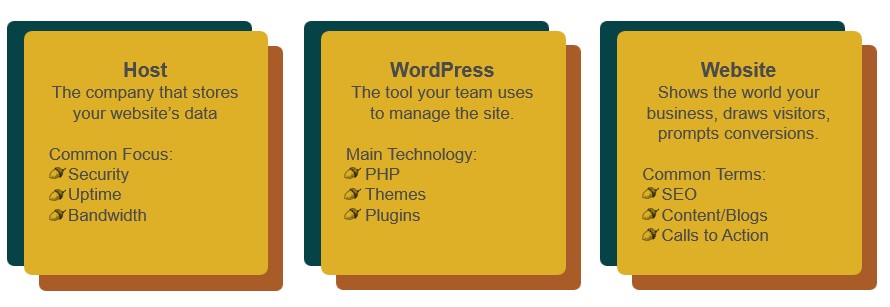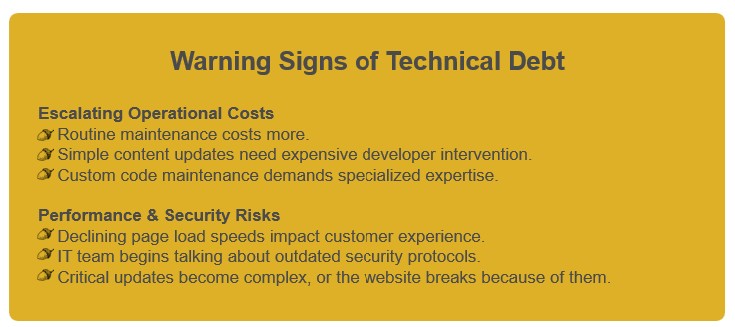Your marketing team has requested a WordPress website redesign. Now it’s your decision to say yes or no.
You must weigh the substantial investment of a redesign against the mounting costs of maintaining your current WordPress infrastructure. It’s not easy to identify and rank the many factors involved. But we’re here to help, with clear, actionable insights to help you make an informed decision.
In this and subequent posts, we'll examine the real financial impact of technical debt, quantify the hidden costs of outdated systems, and provide frameworks for evaluating ROI. Each installment will address key concerns that affect your bottom line, from security vulnerabilities and operational inefficiencies to competitive disadvantages and missed revenue opportunities.
Technical Debt to Business Risk: The True Cost of Your Aging WordPress Website
The website representing your business will be the first encounter most customers and prospects interested in your services, products, and people will have with your brand. When you fail to support your site, you leave these crucial initial interactions to chance.
It’s easy to become complacent about your website, because so many other obligations clamor for attention. No site is set-it-and-forget it; neglect can cost thousands of dollars in repair fees and more in lost short- and long-term revenue. A website that frustrates customers makes them customers of competitors.
Marketing executives who proactively guide their digital teams and keep a close eye on their websites rarely must cope with digital marketing disasters. What’s their secret? What do they focus on to avoid disaster?
The Biggest Threat to Your Bottom Line Is Technical Debt
Most businesses lack the expertise required to maintain WordPress. Knowing the warning signs your team doesn’t talk about (probably because they don’t know about them) is key.
But before we share those warning signs, let’s look at the core elements that work together to make your site function.
How Your WordPress Website Works
Your WordPress website breaks down into three pieces that work together:

The Expertise Gap
Most organizations lack WordPress expertise, and that makes their sites and businesses vulnerable. Your marketing team might excel at driving traffic and creating compelling content, but marketers typically lack the technical knowledge to identify infrastructure risks.
IT departments – skilled in enterprise systems and security – often view WordPress as another department’s marketing tool rather than core infrastructure requiring specialized maintenance.
This expertise gap creates perfect conditions for accumulating technical debt. WordPress websites, which in many cases handle millions in actual and potential revenue, often operate without proper technical oversight. As marketing teams make surface-level updates and IT ensures basic security, crucial maintenance tasks fall through the cracks.
If neither marketing nor IT claims full ownership of WordPress maintenance, your organization likely carries significant technical debt. Rising maintenance costs tend to be the first signs of this debt; simple updates take longer, require expensive external developers, or cause unexpected site issues.

How to Protect Your Bottom Line from Website Technical Debt
The first step in managing your website's technical debt is understanding its true scope.
Conduct separate discussions with your marketing and IT teams about website maintenance. If neither side claims ownership of certain site areas or maintenance tasks, pay attention – these gaps often incur the costliest technical debt. Ask specific questions about update procedures, security protocols, and development workflows. If you hear responses like "we're not sure" or "that's handled by another team," you've identified potential risk areas.
Consider engaging a third-party WordPress specialist for a comprehensive technical audit. While this requires initial investment, it's substantially less than emergency fixes or rushed redesigns when systems fail. A qualified auditor will provide an unbiased assessment of your website's technical health, quantify existing technical debt, and outline specific risks to your business operations. This assessment becomes invaluable for making informed decisions about future website investment and maintenance strategies.
Next Steps
As your organization evaluates its WordPress infrastructure, focus on these key actions:
Conduct a Stakeholder Review
Schedule separate meetings with your marketing and IT teams to understand their current website maintenance processes. Ask direct questions about responsibilities, challenges, and areas where they need additional support. Document any ambiguous ownership areas – these often harbor technical debt.
Initiate a Professional Audit
Engage a qualified WordPress specialist to perform a comprehensive technical assessment. This audit should deliver:
- Clear documentation of current technical debt
- Specific security and performance vulnerabilities
- Estimated costs of delayed maintenance
- Prioritized recommendations for remediation
Based on your findings, establish explicit ownership of WordPress maintenance tasks, whether that ownership is in-house or with a vendor. Clarify responsibility to eliminate future technical debt.
The cost of addressing website technical debt today is invariably lower than managing a crisis tomorrow. Take these steps now to protect your digital infrastructure. Make your WordPress website a valuable business asset rather than a growing liability.
Need help assessing your WordPress website and technical debt risk? Reach out! Our expert WordPress team will get you back on the path to digital success.
Read the second installment in our WordPress Website Redesign Cost Guide 2025 series.